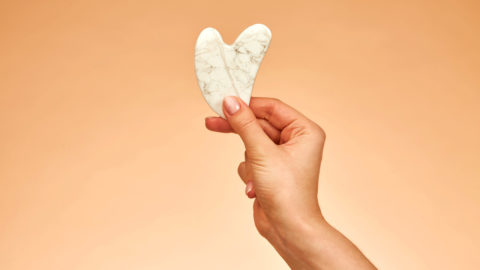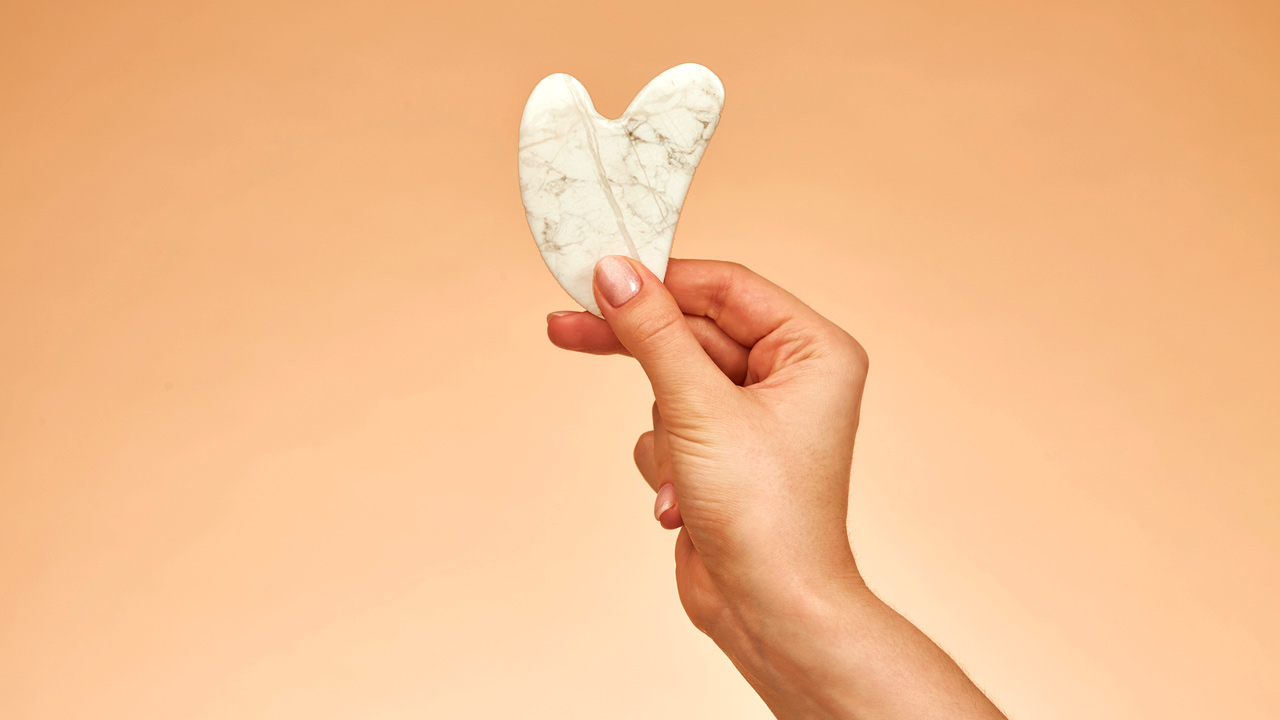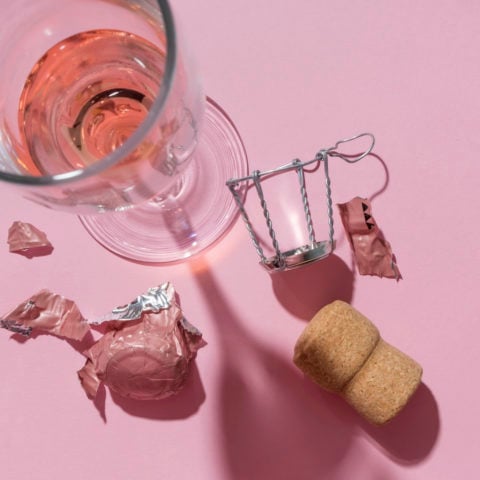The Gua Sha is Your At-Home Facial Hero
Practitioners swear by the facial tool’s ability to reduce muscle tension, smooth fine lines and wrinkles, relieve migraines and even help with acne

You’ve likely encountered the gua sha online, sitting in colour-coordinated shots on Pinterest, gleaming in Instagram flatlays and guest-starring on YouTube skincare tutorials. Celebrities love it too, whether it’s Tracee Ellis Ross or Miranda Kerr. Even Beyoncé is a fan as her longtime makeup artist, Sir John, once revealed. The gua sha is also often incorporated in facial treatments: Province Apothecary offers the Gua Sha Lift Organic Facial, while Odacité’s Temple of Beauty facial at The Detox Market includes the gua sha of your choosing. Suffice to say, like jade rollers, more and more people are incorporating the skincare tool in their regimens. So, what does a gua sha do and how, exactly, are you supposed to use it?
What is gua sha?
Gua sha refers to a massage technique in Traditional Chinese Medicine (TCM) where the skin on the body is vigorously scraped to release toxins and relieve pain. It also aims to move stagnant energy, or qi, from the body. The word “gua sha” (pronounced gwah-shah) roughly translates into “skin scraping.” A flat, smooth tool is used to scrape the skin on the body, which can cause bruising or broken capillaries (Google it if you’re curious, but avoid if you’re squeamish). While similar to the OG full-body method, facial gua sha is noticeably gentler without causing any bruising or tissue damage to the skin.
What are the benefits of using a gua sha?
“Facial gua sha is a massage technique designed to relieve tension in the muscles of the face. It also helps boost blood circulation, encourages lymphatic drainage and works at breaking down the skin fascia,” says Hania Shehadeh, Odacité’s head esthetician. Lymphatic drainage refers to the movement of fluid build-up in the body, helping remove toxins. Meanwhile, the skin fascia is “the connective tissue that hugs the muscles,” explains Shehadeh. “Over time, we get a lot of stress in our fascia so you get that build-up of tension.” Along with helping get rid of muscle tension, practitioners of gua sha swear by the tool’s ability to do everything from smooth out fine lines and wrinkles, relieve migraines and even help with acne.
While there are no available studies on facial gua sha’s long-term benefits, it may help to temporarily increase blood flow to the skin and relieve muscle tension, says Dr. Katie Beleznay, a Vancouver-based dermatologist and clinical instructor at the department of dermatology at the University of British Columbia.
How is a gua sha different from a jade roller?
The gua sha is often compared to the jade roller, which looks like a mini paint roller and comes in a variety of stones like rose quartz and amethyst. “Jade rollers are really good for de-puffing, blood circulation and product penetration,” says Shehadeh. “When you use a gua sha, you go a little deeper within the muscle and get more of a lifting effect and more of a focus on lymphatic drainage.”
How do I incorporate gua sha into my skincare routine?
Always prep the skin with cleansing before using a gua sha. Follow up with your regular skincare products like serum, moisturizer, eye cream and face oil. The latter is essential for creating a nice slip and avoiding tissue damage. She recommends using at least five to 10 drops of face oil, depending on your skin type. If you’re on the drier side, you might need more. Your gua sha will also help with product penetration as you massage them in.
How often should I use a gua sha?
It can be used daily in the morning, evening or both. Try popping it in the fridge or placing it in a glass of cold water for a cooling effect, suggests Shehadeh, which will also help with puffiness and inflammation.
Is there a technique to using the gua sha? Here’s how to use one:
Holding the stone flat against your face at a slight angle, start with your neck or jawline and work your way up and out towards your ears using medium pressure. Once you’re near the top of your ears, stop to wiggle it a bit to encourage lymphatic drainage, and go behind the ears down towards the neck. As you massage, make sure you don’t lift the stone too much. “Pretend you’re buttering a piece of toast,” says Shehadeh. “You want smooth, gliding movements.” Take your time as you do it and enjoy the process.
If you hold a lot of tension in your jaw, take time to focus there before moving to a different area. You can even use it around your neck, shoulders, the back of your thighs or any place you’re experiencing pain or tension.
How long should I spend using a gua sha?
A professional practitioner will perform the treatment until they’re happy with the result (think lifted, radiant skin), but for a beginner, Shehadeh recommends ten strokes for each area of the face. If you’ve seen people Netflix and gua sha, don’t feel pressure to become a pro right away. Practice in front of the mirror until you get the technique down and are comfortable doing it without one. You can use it anywhere, whether it’s on the couch or while lying in bed.
Can you use a gua sha on any skin type?
“If you have very sensitive or rosacea-prone skin, this may not be the best treatment as there can be some friction as the tool is dragged across the skin,” advises Dr. Katie Beleznay. “Also, if someone has active acne, gua sha could exacerbate the acne.” Hold off on using the gua sha until the breakouts have cleared.
Which gua sha is best for me?
The stone comes in many different forms, whether it has scalloped edges, lots of curves or comes in the shape of a heart or comb. Select a stone based on your level of expertise—the simpler the tool, the more beginner-friendly it will be. Meanwhile, more advanced stones will have multiple edges for trying more complex techniques. Choose the one that feels most comfortable to use.
The gua sha is also available in a variety of stones like jade and rose quartz, each one with their own healing properties. Jade, for example, is known for luck and abundance, while rose quartz represents self-love and acceptance. Again, this comes down to personal preference. If you believe in the healing powers of crystals and their energy, go with the one that speaks to you the most. But you can also just pick the one you find the prettiest—no judgement.
Interested in adding a gua sha to your skincare arsenal? Shop the best tools here:
Whether you’re new to the facial tool or know your way around one, here are a few options.
Odacité Crystal Contour Gua Sha Blue Sodalite, $55, thedetoxmarket.ca
Great for beginners, this crystal smooths the appearance of wrinkles and puffiness and uses blue sodalite for grounding, harmony and de-stressing.
Kora Organics Rose Quartz Heart Facial Gua Sha, $58, koraorganics.com
Not just pink and heart-shaped for aesthetic purposes, Kora Organics founder Miranda Kerr wanted a tool that would easily move around the contours of the face and chose rose quartz for its soothing energy and encouragement of love and acceptance.
Herbivore Rose Quartz Gua Sha, $24, sephora.ca
This wing-shaped gua sha has three edges created for different massage techniques, whether it’s to sculpt and reduce puffiness or provide a gentle pressure and massage.
The Lanshin Pro, $165, thedetoxmarket.ca
Created by acupuncturist Sandra Lanshin Chiu, this black nephrite jade stone is known for its healing properties and lets you level up your gua sha technique with its multiple curves and edges.
Métange Obsidian Gua Sha Stone, $49, metangebeauty.com (available May 1)
From newly launched Toronto-based brand, Métange, this gua sha uses obsidian—made from molten volcanic ash—for healing, protection and absorbing negative energy. Each stone comes in a reusable metal tin and a soft case.








